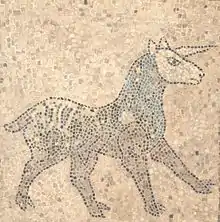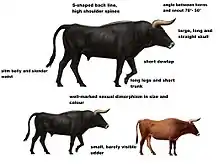Re'em
A re'em, also reëm (Hebrew: רְאֵם), is an animal mentioned nine times in the Hebrew Bible[1] It has been translated in some Christian Bible translations as "oryx" (which was accepted as the referent in Modern Hebrew) and as "unicorn" in the King James Version.


Translation
The King James Version of the Book of Job followed the Septuagint and Jerome's Vulgate in the translation of re'em into unicorn:
Will the unicorn be willing to serve thee, or abide by thy crib? Canst thou bind the unicorn with his band in the furrow? or will he harrow the valleys after thee? Wilt thou trust him, because his strength is great? or wilt thou leave thy labour to him? Wilt thou believe him, that he will bring home thy seed, and gather it into thy barn?
Some Bible translations into English, including the American Standard Version and New American Standard Bible, interpret re'em as "wild ox".
Jewish mythology
In Jewish folklore, the re'em was larger than a mountain and could dam the river Jordan with its dung. To survive during the deluge, Noah had to strap its horns to the side of the Ark so that its nostril could protrude into the Ark, allowing the animal to breathe. King David, while still a shepherd, mistook its horn for a mountain and climbed it, and then the re'em got up, carrying David up to the heavens. He prayed to God to save him, so a lion passed in front of the re'em. As the re'em bowed down to the king of beasts, David climbed off but was threatened by the lion. He prayed again, and an animal passed by so the lion could chase it and leave David unharmed.[2]
The re'em is also mentioned in Tractate Zebahim 113b, saying in short that it took a tremendous miracle for one to actually survive the deluge. The association may be linked to the mythical beast Behemoth, described in other areas of Jewish mythology, aggada, and Kabbala due to the striking parallels between the two beasts.
Translation as aurochs

It was first identified in modern times with the aurochs by Johann Ulrich Duerst, who discovered it was based on the Akkadian cognate rimu (𒄠 in cuneiform), meaning Bos primigenius, the aurochs, progenitor of cattle.[3] This has been generally accepted,[4] as it is today even among religious scholars.
References
- Job 39:9–10, Deuteronomy 33:17, Numbers 23:22 and 24:8; Psalms 22:21, 29:6 and 92:10; and Isaiah 34:7.
- Graves, Robert; Patai, Raphael (2014). "Chapter 7: The Reem and the Ziz". Hebrew Myths: The Book of Genesis (e-pub ed.). RosettaBooks. ISBN 9780795337154.
- Die Rinder von Babylonien, Assyrien und Ägypten (Berlin, 1899:7–8)
- For instance Jonas Salo, "Cattle Raising in Palestine" Agricultural History 26.3 (July 1952), pp. 93–104.